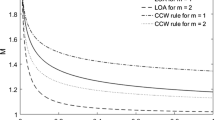Abstract
The development of perturbations of the parameters of a dense gaseous envelope traveling with an acceleration driven by a difference in the pressures on either side is investigated numerically. Plane and axisymmetric time-dependent flows of a compressible medium are considered. The effect of both the density of the envelope and the form of the initial perturbations of its shape and motion on the mass cumulation in the compactions formed is studied. The evolutions of the perturbations of a layer and the surface of a contact discontinuity accelerated by an impinging plane shock wave are compared.
Similar content being viewed by others
References
M.A. Lavrent’ev, “Cumulative Charge and Its Principles of Operation,” Usp. Mat. Nauk 12, No. 4, 41–56 (1957).
M.A. Lavrent’ev and B.V. Shabat, Hydrodynamic Problems and their Mathematical Models (Nauka, Moscow, 1973) [in Russian].
E. Ott, “Nonlinear Evolution of the Rayleigh-Taylor Instability of a Thin Layer,” Phys. Rev. Lett. 29, No. 21, 1429–1432 (1972).
S.I. Anisimov, A.M. Prokhorov, and V.E. Fortov, “Use of Powerful Lasers for Investigating Matter at Superhigh Pressures,” Usp. Fiz. Nauk 142, No. 3, 395–434 (1984).
L.P. Orlenko (Ed.), Physics of Explosion Vol. 2 (Fizmatlit, Moscow, 2002) [in Russian].
S.I. Zonenko and G.G. Chernyi, “New Form of Cumulation of the Energy and Momentum of Plates and Shells Propelled by an Explosion,” Dokl. Ros. Akad. Nauk 390, No. 1, 46–50 (2003).
A.N. Golubyatnikov, S.I. Zonenko, and G.G. Chernyi, “New Models and Problems of the Theory of Cumulation,” Uspekhi Mekhaniki 3, No. 1, 31–93 (2005).
V.B. Baranov and K.V. Krasnobaev, Hydrodynamic Theory of Cosmic Plasma (Nauka, Moscow, 1977) [in Russian].
S.A. Kaplan and S.B. Pikel’ner, Physics of the Interstellar Medium (Nauka, Moscow, 1979) [in Russian].
S.R. Pottasch, Planetary Nebulae (Cluwer, Dordrecht etc., 1984; Mir, Moscow, 1987).
D.E. Osterbrock and G.J. Ferland Astrophysics of Gaseous Nebulae and Active Galactic Nuclei, 2 (University Science Books, Sausakiti, C.A., 2006).
B.G. Elmegreen and C.J. Lada, “Sequential Formation of Subgroups in OB Associations,” Astrophys. J. 214, 725–741 (1977).
G. Garcia-Segura and J. Franco, “From Ultracompact to Extended HII Regions,” Astrophys. J. 469, No. 1, Pt. 1, 171–188 (1996).
B. Lefloch, B. Lazareff, and A. Castets, “Cometary Globules. III. Triggered Star Formation in IC 1848,” Astron. Astrophys. 324, 249–262 (1997).
K.V. Krasnobaev, “Instability of a Thin Photoevaporable Circumstellar Envelope,” Pis’ma v Astron. Zhurn. 30, No. 7, 500–505 (2004).
E.R. Capriotti and A.D. Kendall, “The Origin and Physical Properties of the Cometary Knots in NGC 7293,” Astrophys. J. 642, 923–932 (2006).
E.E. Meshkov, “Instability of the Interface between Two Gases Accelerated by a ShockWave,” Fluid Dynamics 4(5), 101–104 (1969).
A. Mizuta, J.O. Kane, M.W. Pound, B.A. Remington, D.D. Ryutov, and H. Takabe, “Hydrodynamic Instability of Ionization Fronts in HII Regions,” Astrophys. J. 621, 803–815 (2005).
G.G. Chernyi, Gas Dynamics (Nauka, Moscow, 1988) [in Russian].
G.Yu. Kotova and K.V. Krasnobaev, “Nonlinear Deformations of an Accelerated Moving Radiating Envelope,” Zhurn. Khim. Fiziki (2008) (in press).
J. Taylor, “The Instability of Liquid Surfaces when Accelerated in a Direction Perpendicular to their Planes I,” Proc. Roy. Soc. London. Ser. A. 201, No. 1065, 192–196 (1950).
R.D. Richtmyer, “Taylor Instability in Shock Acceleration of Compressible Fluids,” Communs. Pure and Appl. Math. 13, No. 2, 297–319 (1960).
E.E. Meshkov, “Some Results of Experimental Investigations of the Gravitational Instability of Interfaces between Media of Different Densities,” in: K.I. Babenko (Ed.) Investigation of Hydrodynamic Stability by Means of Computers (Inst. of Applied Mathematics of the Academy of Sciences of the USSR, Moscow, 1981) [in Russian], 63–190.
S.Ya. Gertsenshtein and V.M. Chernyavskii, “On the Nonlinear Development of Two-and Three-Dimensional Perturbations in the Presence of Rayleigh-Taylor Instability,” Fluid Dynamics 20(2), 199–206 (1985).
V. E. Neuvazhaev and I. E. Parshukov, “Study of the Stability of Interfaces between Fluids Subjected to the Joint Action of Pulsed and Constant Accelerations,” Mat. Modelirovanie, 5, No. 2, 16–24 (1993).
Additional information
Original Russian Text © K.V. Krasnobaev, R.R. Tagirova, 2008, published in Izvestiya Rossiiskoi Akademii Nauk, Mekhanika Zhidkosti i Gaza, 2008, Vol. 43, No. 5, pp. 161–170.
Rights and permissions
About this article
Cite this article
Krasnobaev, K.V., Tagirova, R.R. Simulation of the instability of an accelerating gaseous envelope. Fluid Dyn 43, 814–822 (2008). https://doi.org/10.1134/S0015462808050165
Received:
Published:
Issue Date:
DOI: https://doi.org/10.1134/S0015462808050165



